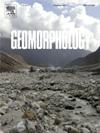Towards an understanding of dynamics of blue-ice moraines: A case study in the Grove Mountains, East Antarctica
IF 3.1
2区 地球科学
Q2 GEOGRAPHY, PHYSICAL
引用次数: 0
Abstract
Knowledge regarding former behavior of the East Antarctic Ice Sheet (EAIS) is crucial for assessing global sea-level change and understanding the global climate system. Yet, it remains challenging to examine pre-Last Glacial Maximum (LGM) glacial histories of the EAIS due to the limitations of the traditional geologic records. Recent studies suggest that blue ice areas (BIAs) and associated deposits (e.g. supraglacial moraines) have a potential to overcome this problem. However, the relationship between blue-ice evolution and climate changes is not yet well examined. In this study, we investigate two types of BIAs in the Grove Mountains, EAIS, on the basis of surface exposure dating of erratic boulders and cobbles on blue-ice moraines at Mount Harding and Escarpment. Here, we present 27 new ages, including single (10Be; n = 10) and paired (10Be and 26Al, n = 17) exposure-ages. The newly-obtained ages, along with previously-published 10Be data (n = 40), indicate that the studied BIAs have been relatively stagnant since the LGM, and that blue-ice moraines formed in a closed system are much older than those built in the absence of a barrier. Also, the compilation implies multiple phases of pre-LGM ice flow that corresponded to global cold periods. We suggest that there was likely a response of blue-ice evolution to Antarctic glaciations on orbital timescales.
了解蓝冰冰碛的动态:南极洲东部格罗夫山案例研究
本文章由计算机程序翻译,如有差异,请以英文原文为准。
求助全文
约1分钟内获得全文
求助全文
来源期刊

Geomorphology
地学-地球科学综合
CiteScore
8.00
自引率
10.30%
发文量
309
审稿时长
3.4 months
期刊介绍:
Our journal''s scope includes geomorphic themes of: tectonics and regional structure; glacial processes and landforms; fluvial sequences, Quaternary environmental change and dating; fluvial processes and landforms; mass movement, slopes and periglacial processes; hillslopes and soil erosion; weathering, karst and soils; aeolian processes and landforms, coastal dunes and arid environments; coastal and marine processes, estuaries and lakes; modelling, theoretical and quantitative geomorphology; DEM, GIS and remote sensing methods and applications; hazards, applied and planetary geomorphology; and volcanics.
 求助内容:
求助内容: 应助结果提醒方式:
应助结果提醒方式:


